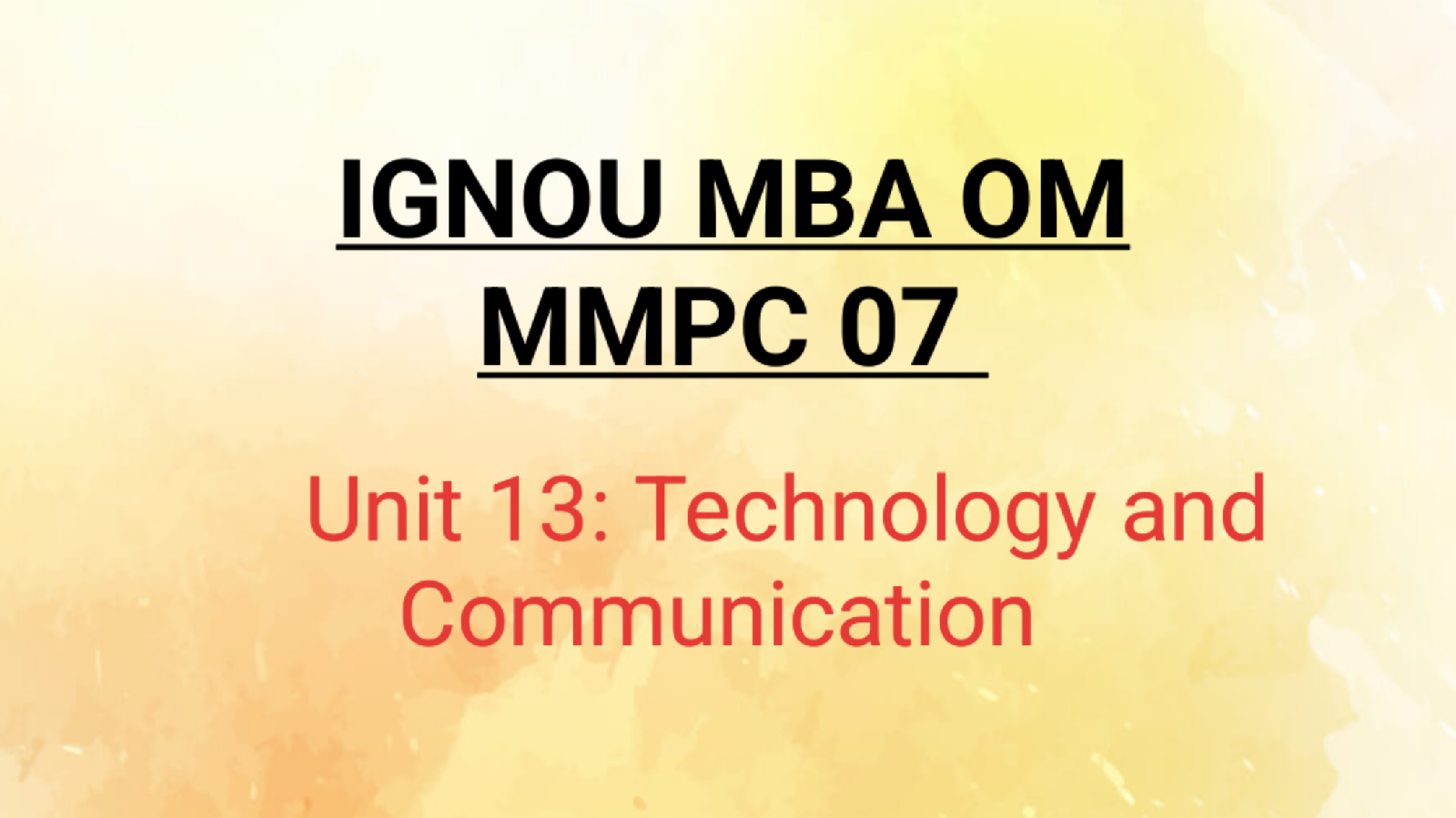Class for IGNOU MBA Subject MMPC-07: Business Communication
Unit 13: Technology and Communication
1. Introduction to Technology and Communication
Technology has revolutionized the way we communicate, both in our personal and professional lives. From emails and video conferencing to social media and instant messaging, technological advancements have significantly impacted business communication, making it faster, more efficient, and more accessible across distances.
2. Importance of Technology in Communication
-
Speed and Efficiency: Technology allows for instant communication, eliminating delays and making it easier to exchange information quickly.
- Example: Emails can be sent across the globe in seconds, allowing businesses to operate in real-time.
-
Global Connectivity: Technology enables communication across geographic boundaries, allowing teams to collaborate internationally.
- Example: Video conferencing tools like Zoom enable teams to hold meetings from different countries without the need for travel.
-
Cost-Effective Communication: Technological tools such as emails, instant messaging, and VoIP reduce the cost of communication compared to traditional methods like postal services or phone calls.
- Example: Companies use Slack or Microsoft Teams for free or low-cost internal communication instead of relying on costly phone systems.
-
Improved Access to Information: Digital communication platforms allow for the easy sharing and retrieval of information.
- Example: Cloud storage services like Google Drive enable teams to access documents and data from anywhere with an internet connection.
3. Forms of Technology in Communication
-
Emails:
- Emails are the most commonly used form of professional communication. They allow for written, formal exchanges and can be used to share documents, contracts, and reports.
- Advantages: Quick, documented, and easily searchable.
- Example: Sending a project update to a client via email, attaching reports and other necessary documents.
-
Instant Messaging (IM):
- IM platforms such as WhatsApp, Slack, and Microsoft Teams provide real-time text communication and are often used for quick, informal exchanges within organizations.
- Advantages: Immediate, less formal, and allows for quick feedback.
- Example: A manager uses Slack to communicate with team members about an upcoming deadline.
-
Video Conferencing:
- Video conferencing platforms such as Zoom, Microsoft Teams, and Google Meet allow for face-to-face virtual meetings, bridging the gap between remote employees.
- Advantages: Personal, real-time, and allows for visual communication.
- Example: Conducting a virtual job interview or team meeting via Zoom.
-
Social Media:
- Social media platforms like LinkedIn, Twitter, and Facebook are used for professional networking, marketing, and customer engagement.
- Advantages: Large reach, informal networking, and brand building.
- Example: A company promotes its new product launch through posts on its LinkedIn page.
-
Cloud-Based Collaboration Tools:
- Platforms such as Google Workspace, Microsoft 365, and Dropbox allow teams to collaborate on projects and share files in real-time, regardless of location.
- Advantages: Collaboration from anywhere, real-time editing, and version control.
- Example: Employees working on a shared document using Google Docs to edit and update content simultaneously.
-
Artificial Intelligence (AI) in Communication:
- AI tools such as chatbots and automated email responders enhance communication by handling routine tasks like answering frequently asked questions or sending out automated updates.
- Advantages: Efficiency, 24/7 availability, and scalability.
- Example: A chatbot on a company’s website provides instant customer support by answering product-related questions.
4. Benefits of Technology in Communication
-
Enhanced Productivity: Technology allows employees to communicate and collaborate more efficiently, increasing overall productivity.
- Example: Teams using Trello or Asana for task management can track progress and communicate updates seamlessly.
-
Remote Work: Technology enables remote working environments, allowing employees to work from home or anywhere with an internet connection.
- Example: A fully remote team stays connected through daily Zoom calls and shared project management tools.
-
Greater Flexibility: Employees can communicate and access work-related information at any time, providing greater flexibility in terms of working hours and locations.
- Example: An employee responds to work emails during off-hours using their smartphone.
-
Automation of Routine Communication: AI-driven communication tools can automate routine tasks such as sending email reminders or responding to frequently asked questions, allowing employees to focus on higher-value tasks.
- Example: A marketing team uses email automation to send regular newsletters to subscribers.
5. Challenges of Technology in Communication
-
Over-Dependence on Technology: Relying too much on technology can reduce personal interaction and may lead to communication breakdowns if there are technical issues.
- Example: A critical virtual meeting is delayed due to a Zoom server outage.
-
Data Security and Privacy Concerns: With the increased use of digital communication tools, there is a higher risk of data breaches and security issues.
- Example: An employee accidentally shares confidential business data through an unsecured email.
-
Digital Fatigue: Constant use of technology for communication, especially video conferencing, can lead to digital fatigue and burnout.
- Example: Employees experience “Zoom fatigue” after attending multiple video meetings in a single day.
-
Miscommunication: The lack of non-verbal cues in digital communication, especially in text-based formats like emails or instant messages, can lead to misunderstandings.
- Example: A message meant to be humorous in a Slack conversation is misinterpreted as sarcastic, causing confusion.
6. The Future of Technology in Communication
-
Increased Use of AI: AI-powered communication tools such as chatbots and virtual assistants will continue to evolve, taking on more complex tasks like scheduling meetings or drafting initial responses to emails.
- Example: AI-based tools automatically draft a meeting agenda based on previous email discussions.
-
Augmented Reality (AR) and Virtual Reality (VR): AR and VR technologies will allow for more immersive communication, particularly in remote work environments.
- Example: Teams use VR to conduct virtual meetings in a fully immersive digital workspace.
-
5G Networks: The advent of 5G technology will further improve communication speeds and the reliability of video calls, especially in remote areas.
- Example: Seamless video conferencing with no lag or connectivity issues, even for teams in remote locations.
7. Experiment and Case Study
Case Study 1: Implementation of Slack in an Organization
An organization that previously relied on emails for internal communication adopted Slack for instant messaging and collaboration. As a result, communication between departments became faster, and project coordination improved, reducing overall email traffic by 40%.
Experiment 1: Using AI for Automated Responses
A company experimented with using an AI-powered chatbot to handle customer inquiries on their website. The chatbot was able to resolve 70% of queries without human intervention, allowing the customer support team to focus on more complex issues.
8. Assignment Questions
- Discuss the role of technology in enhancing business communication. Provide examples of tools commonly used in the workplace.
- Analyze the benefits and challenges of remote communication tools such as Zoom or Microsoft Teams.
- How can artificial intelligence (AI) improve communication efficiency in organizations? Provide real-life examples.
9. Self-Study Questions
- What are the advantages of using cloud-based collaboration tools for team projects?
- How can video conferencing tools improve communication for remote teams?
- What are the risks associated with the increased use of technology in business communication?
10. Exam Questions
- Explain how technological advancements have transformed business communication in the modern workplace.
- Discuss the various forms of technology used in business communication and their advantages.
- What are the challenges of using technology for communication in organizations? How can these challenges be addressed?
This class on Unit 13: Technology and Communication provides a detailed overview of how technological advancements have impacted communication in the workplace. It also explores the benefits, challenges, and future trends in the use of technology for business communication. Practical examples, case studies, and assignments are included to ensure a thorough understanding of the subject.





















